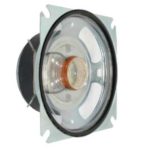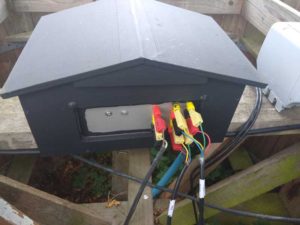In a nutshell:
Big Bird was made to go on the gatepost to our house. Mike and Milo decided on a project to make him turn.
The technical details are below.
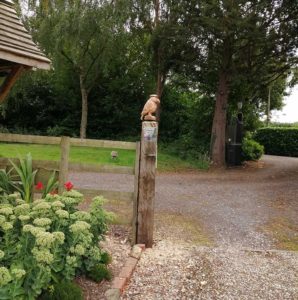
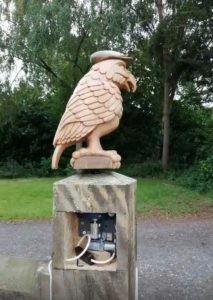
Mr Big Bird looked lonely so Mike asked for a second one, so Tina made him a wife.
By this time they also thought they should be able to talk to each other ……
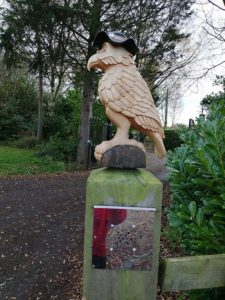
How it was made - the technical stuff
Motor Mechanism
We needed to make an electric motor mechanism that was geared right down to give a slow turn. To make this we sourced the following.
Motor – would work up to 12V but 3.5 V gave a slow turn. (Amazon £13.1)

Bearing to hold a 12mm shaft to go through the post connecting big bird to the motor. (Simply bearings £10.01 + Vat)

Coupling to connect the 6mm shaft on the motor to the more substantial 12mm main shaft. (Amazon £7.43).
The 12mm steel shaft itself was from the bits and pieces bin. These items were bolted to a steel plate (bits and pieces bin) and fixed in a hollowed-out section of the post. A steel plate was fastened to the protruding part of the shaft which could be screwed to the base of Big Bird. The photograph top right shows this all connected together.
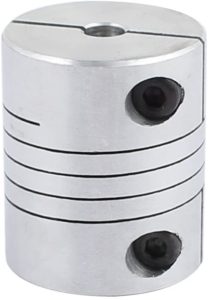
Control Mechanism
We wanted Big Bird to rotate at intervals and maybe do some sort of dance. To do this we used an Arduino microprocessor fitted with a relay mechanism so the direction of motion could be controlled. The relay board is one that fits directly onto the Arduino board. There are a variety of suppliers – total cost for the two boards is about £40.
The picture shows both boards – the relay board is designed to sit on top with pins automatically connecting the two.
The code to operate this is written in Arduino’s own development environment. The code is very C like.
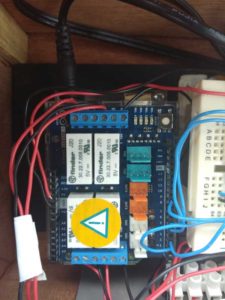
After a while it was decided to break the motion so that Big Bird did a regular twizzle at about 5 minutes interval, but that a specialized random movement should happen when somebody or thing approached the gate post.
This involved connecting the Arduino to a PIR (passive infra-red) detector. These are available cheaply for less than £2.
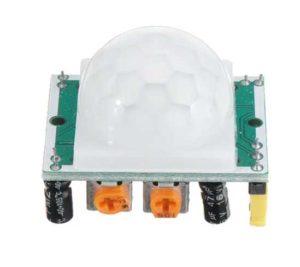
This was mounted onto the gatepost and a separate 3 core wire was fed into the control unit. After some experimentation it was found to work best when housed in a tube. The photo below shows the housing. The tin lid is a temporary extra as when the sun is low and shines into the tube, then the PIR triggers continuously. So, the tin is shading the PIR. More experiments are needed to make this a bit neater.
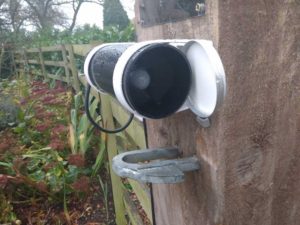
Mrs Bird and the conversations
After this had been working for a while we decided that Mr Big Bird should have a Mrs Big Bird on the other gate post. In addition it would be nice if they could talk to one another. To start with we bought a pair of very cheap (£2) voice recorders. But the quality of these was so poor we had to look for something else. We found a sound device that could play MP3 files from a mini SD card at a cost of £6.82.
This together with a cheap amplifier (£7.99) it seemed to work well.


Here is an image of the complete set up. It could be triggered via the Arduino whenever the PIR detected movement.
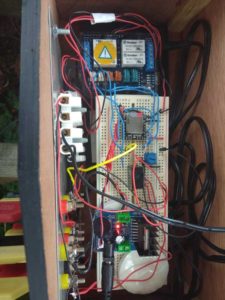
The final element was to find speakers and fit these into the gatepost cavities. The best speakers were from RS components who were able to provide small speakers that had waterproof cones – about £9 each. Although the speakers are housed in the cavities with a stainless steel grill (bits and pieces bin – with holes drilled in to rectangles cut from excess cooker hood chimney) they will inevitably get damp so waterproof cones are needed.
The rest of the project consists creating the files on the micro sd card and arranging the code so that each bird could speak in turn and the addition of a extra relay to switch the sound to the appropriate gatepost speaker, depending on who is speaking.
By now the two birds were starting to take in some character in our minds. Tina downloaded text-to-speech voices from CereProc.com We chose a black country accent for Mrs Big Bird – now called Ethel and a Scottish accent for Mr Big Bird – now called Robbie.
All the equipment was installed into a “house” being kept from the worst of the weather under a faux wishing well. Here is what the house looks like.
